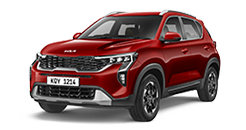open menu
- Home>
- Discover Kia>
- ASK>
- What is a Blind Spot Monitor?
What is a Blind Spot Monitor?
“The Blind-Spot Collision Warning is a driving assistance system that notifies the driver if another vehicle has appeared within their blind spot and is at risk of a collision.”
What is a Blind-Spot Collision Warning?
A Blind-Spot Collision Warning is one of the many advanced driving assistance systems that help prevent accidents from occurring. This specific driving safety system notifies the driver if another vehicle has appeared within their blind spot or if another vehicle has switched into an adjacent lane and is at risk of a collision.
How a Blind-Spot Collision Warning Works
With this specific driving safety system, your vehicle uses the sensors located on the rear bumper and side mirrors to check if there are any vehicles within your blind spot or in the lanes beside you. If the sensors detect an oncoming vehicle that is within a certain proximity or is not visible in the driver’s blind spot, an audible warning and signal will appear on the side mirror. However, these warnings may differ depending on the model of the vehicle, so it is best to check your driver’s manual to understand the various warning signs and see if this system is available on your vehicle.

To activate this safety system on your Kia, press the ‘Blind-Spot Collision Warning’ button. Once the vehicle reaches 30km/h (approximately 19 mph) the Blind Spot Collision Warning icon will appear on the dashboard, showing that the rear and side radar sensors have been activated. Thus, giving the driver a real-time update on their driving situation and help prevent hazardous situations. If a vehicle is detected in the blind spot or if there is a possibility of a collision, the warning signal on the side mirrors will illuminate. If the driver switches the turn signal in the same direction, not only will the warning signal continue to stay on, but an audible warning will also be activated.

Types of Blind-Spot Collision Technologies
There are a variety of blind-spot collision technologies that vary from pre-installed blind spot monitors that come with this safety feature when purchasing your vehicle to monitors that require self-installation or even blind spot monitor systems that recognize a trailer has been connected to the vehicle. In addition, these blind spot monitors not only use radars to give a better depiction of the vehicles around you, but they also use ultrasonic waves and cameras to help get a clearer, more accurate picture of your current driving environment.
Recently, a new type of technology has been developed to work hand-in-hand with blind spot monitors, known as “Blind-Spot Collision Avoidance Assist”. The Blind-Spot Collision Avoidance Assist works in harmony with the Blind-Spot Collision Warning. If the driver turns on the signal to change lanes while both the illuminated visual and audio warning from the Blind-Spot Collision Warning is on, and the vehicle starts to move toward the signaled direction, the Blind-Spot Collision Avoidance Assist system will apply the brakes on the opposite wheel to prevent the vehicle from switching lanes. Thus, preventing a collision and potentially dangerous accident. Please note that the Blind-Spot Collision Avoidance Assist must also be activated before use.
With the continuous advancement in driver-assisted technology, such as Blind-Spot Collision Warning and Blind-Spot Collision Avoidance Assist, not only can they protect the driver behind the wheel, but also protect those around them regardless of the size and length of the vehicle.
Usage Precautions
- When using either of these safety systems, always remember that safe driver-assisted technology is never a replacement nor a substitute for safe driving practices.
- Before you activate the Blind-Spot Collision Warning or any of the other advanced driving assistance systems, be sure to check your owner’s manual for important information such as how to operate the system, what kind of warnings or alerts will appear, etc.
- Prior to getting into your vehicle, you should check to ensure the sensors of your blind spot monitor are not covered by dirt, snow, or other objects.
- The blind spot monitor system is designed for highway use due to the frequent lane changes and fast speed. However, if the vehicle next to you is going at a particularly fast or slow speed the sensors might not register the vehicle in time.
- Also, keep in mind, this safety system is programmed to identify other vehicles traveling at a certain speed and is not optimized to detect motorcycles, mopeds, bicycles, scooters, and pedestrians.







